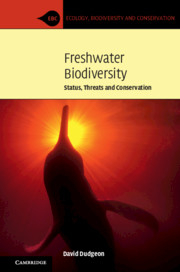29 results
Foreword
-
- Book:
- Freshwater Biodiversity
- Published online:
- 16 June 2020
- Print publication:
- 21 May 2020, pp x-xiv
-
- Chapter
- Export citation
1 - The Freshwater Commons
-
- Book:
- Freshwater Biodiversity
- Published online:
- 16 June 2020
- Print publication:
- 21 May 2020, pp 1-33
-
- Chapter
- Export citation

Freshwater Biodiversity
- Status, Threats and Conservation
-
- Published online:
- 16 June 2020
- Print publication:
- 21 May 2020
2 - Global Endangerment of Freshwater Biodiversity
-
- Book:
- Freshwater Biodiversity
- Published online:
- 16 June 2020
- Print publication:
- 21 May 2020, pp 34-60
-
- Chapter
- Export citation
9 - Conservation of Freshwater Biodiversity
-
- Book:
- Freshwater Biodiversity
- Published online:
- 16 June 2020
- Print publication:
- 21 May 2020, pp 356-398
-
- Chapter
- Export citation
6 - Vanishing Lakes and Threats to Lacustrine Biodiversity
-
- Book:
- Freshwater Biodiversity
- Published online:
- 16 June 2020
- Print publication:
- 21 May 2020, pp 259-290
-
- Chapter
- Export citation
Permissions for Epigraphs
-
- Book:
- Freshwater Biodiversity
- Published online:
- 16 June 2020
- Print publication:
- 21 May 2020, pp xv-xvi
-
- Chapter
- Export citation
General Index
-
- Book:
- Freshwater Biodiversity
- Published online:
- 16 June 2020
- Print publication:
- 21 May 2020, pp 489-500
-
- Chapter
- Export citation
Plate Section (PDF Only)
-
- Book:
- Freshwater Biodiversity
- Published online:
- 16 June 2020
- Print publication:
- 21 May 2020, pp 501-516
-
- Chapter
- Export citation
References
-
- Book:
- Freshwater Biodiversity
- Published online:
- 16 June 2020
- Print publication:
- 21 May 2020, pp 405-470
-
- Chapter
- Export citation
Afterword
-
- Book:
- Freshwater Biodiversity
- Published online:
- 16 June 2020
- Print publication:
- 21 May 2020, pp 399-404
-
- Chapter
- Export citation
3 - Overexploitation
-
- Book:
- Freshwater Biodiversity
- Published online:
- 16 June 2020
- Print publication:
- 21 May 2020, pp 61-122
-
- Chapter
- Export citation
Epigraph
-
- Book:
- Freshwater Biodiversity
- Published online:
- 16 June 2020
- Print publication:
- 21 May 2020, pp vii-viii
-
- Chapter
- Export citation
Copyright page
-
- Book:
- Freshwater Biodiversity
- Published online:
- 16 June 2020
- Print publication:
- 21 May 2020, pp vi-vi
-
- Chapter
- Export citation
7 - How Will Climate Change Affect Freshwater Biodiversity?
-
- Book:
- Freshwater Biodiversity
- Published online:
- 16 June 2020
- Print publication:
- 21 May 2020, pp 291-331
-
- Chapter
- Export citation
5 - River Regulation
-
- Book:
- Freshwater Biodiversity
- Published online:
- 16 June 2020
- Print publication:
- 21 May 2020, pp 216-258
-
- Chapter
- Export citation
Species Index
-
- Book:
- Freshwater Biodiversity
- Published online:
- 16 June 2020
- Print publication:
- 21 May 2020, pp 471-488
-
- Chapter
- Export citation
4 - Alien Species and Their Effects
-
- Book:
- Freshwater Biodiversity
- Published online:
- 16 June 2020
- Print publication:
- 21 May 2020, pp 123-215
-
- Chapter
- Export citation
8 - Ecosystem Services and Incentivizing Conservation of Freshwater Biodiversity
-
- Book:
- Freshwater Biodiversity
- Published online:
- 16 June 2020
- Print publication:
- 21 May 2020, pp 332-355
-
- Chapter
- Export citation
Contents
-
- Book:
- Freshwater Biodiversity
- Published online:
- 16 June 2020
- Print publication:
- 21 May 2020, pp ix-ix
-
- Chapter
- Export citation



